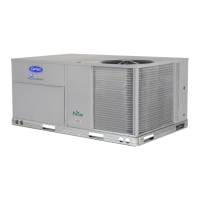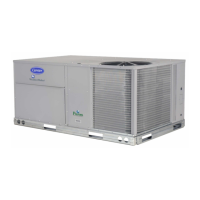70
OPERATION FOR CV
On CV units equipped with a VFD (staged air volume) when
SP.CF, SP.SV, and SP.S are configured, the ComfortLink con-
trol will control the speed of the supply fan based on the oper-
ating mode of the unit. The VFD speed setting points are
SP.MN, SP.MX. When in LOW COOL mode and the compres-
sor stage is less than 50%, fan will be at SP.MN minimum
speed. When greater than 50% capacity, the fan will be at
SP.MX maximum speed. In VENT mode, the fan speed will be
at SP.MN minimum speed. In HEATING mode, the fan will
operate at 75% speed when the heating stage is 75% or less and
at 100% speed when the heating stage is greater than 75%. On
units configured for 2 stage thermostat operation, the fan will
be at 100% on a call for W2 and at 75% on a call for only W1.
SETTING UP THE SYSTEM
The options for static pressure control are found under the Lo-
cal Display Mode Configuration
SP. See Table 59.
Static Pressure Configuration (SP.CF)
This variable is used to configure the use of ComfortLink con-
trols for static pressure control.
When set to disable, there is no static pressure control by Com-
fortLink controls. This would be used for a constant volume
(CV) application when static pressure control is not required or
for a VAV application if there will be third-party control of the
VFD. In this latter case, a suitable means of control must be
field installed.
When set to enable, this will enable the use of ComfortLink con-
trols for static pressure control via a supply fan VFD. On CV
units with VFD, staged air volume, this must be set to disable.
Staged Air Volume Control (SP.SV)
This variable enabled the use of a CV unit with VFD for staged
air volume control.
Static Pressure Sensor (SP.S)
This variable enables the use of a supply duct static pressure
sensor. This must be enabled to use ComfortLink controls for
static pressure control. If using a third-party control for the
VFD or IGV, this should be disabled. Do not use when SP.SV
is enabled.
Static Pressure Low Range (SP.LO)
This is the minimum static pressure that the sensor will mea-
sure. For most sensors, this will be 0 in. wg. The ComfortLink
controls will map this value to a 4 mA sensor input.
Static Pressure High Range (SP.HI)
This is the maximum static pressure that the sensor will mea-
sure. Commonly, this will be 5 in. wg. The ComfortLink con-
trols will map this value to a 20 mA sensor input.
Static Pressure Set Point (SP.SP)
This is the static pressure control point. It is the point against
which the ComfortLink controls compare the actual measured
supply duct pressure for determination of the error that is used
for PID control. Generally, one would set SP.SP to the mini-
mum value necessary for proper operation of air terminals in
the conditioned space at all load conditions. Too high of a val-
ue will cause unnecessary fan motor power consumption at
part-load conditions and/or noise problems. Too low a value
will result in insufficient airflow. Additional information will
be found on page 71, under Static Pressure Reset.
VFD Minimum Speed (SP.MN)
This is the minimum speed for the supply fan VFD. Typically,
the value is chosen to maintain a minimum level of ventilation.
NOTE: Most VFDs have a built-in minimum speed adjustment
which must be configured for 0% when using ComfortLink con-
trols for static pressure control. When SP.SV is enabled, the range
is 33 to 67% with the default setting of 67%.
VFD Maximum Speed (SP.MX)
This is the maximum speed for the supply fan VFD. This is
usually set to 100%.
VFD Fire Speed Override (SP.FS)
This is the speed that the supply fan VFD will use during the
fire modes; pressurization, evacuation and purge. This is usual-
ly set to 100%.
Static Pressure Reset Configuration (SP.RS)
This option is used to configure the static pressure reset func-
tion. When SP.RS = 0, there is no static pressure reset via an
analog input. When SP.RS = 1, there is static pressure reset
based on the CEM 4-20MA input and ranged from 0 to
3 in. wg. When SP.RS = 2, there is static pressure reset based
on RAT and defined by SP.RT and SP.LM. When SP.RS = 3,
there is static pressure reset based on SPT and defined by
SP.RT and SP.LM. When SP.RS = 4, there is VFD speed con-
trol where 0 mA = 0% speed and 20 mA = 100% (SP.MN and
SP.MX will override).
Static Pressure Reset Ratio (SP.RT)
This option defines the reset ratio in terms of static pressure
versus temperature. The reset ratio determines how much the
static pressure is reduced for every degree below set point for
RAT or SPT.
Table 59 — Static Pressure Control Configuration
ITEM EXPANSION RANGE UNITS CCN POINT DEFAULT
SP SUPPLY STATIC PRESS.CFG.
SP.CF Static Pressure Config Enable/Disable STATICFG Disable
SP.SV Staged Air Volume Control Enable/Disable STGAVCFG Disable
SP.S Static Pressure Sensor Enable/Disable SPSENS Disable
SP.LO Static Press. Low Range –10 to 0 in. W.C. SP_LOW 0
SP.HI Static Press. High Range 0 to 10 in. W.C. SP_HIGH 5
SP.SP Static Pressure Setpoint 0 to 5 in. W.C. SPSP 1.5
SP.MN VFD Minimum Speed 0 to 100 % STATPMIN 20
SP.MX VFD Maximum Speed 0 to 100 % STATPMAX 100
SP.FS VFD Fire Speed Over. 0 to 100 % STATPFSO 100
SP.RS Stat. Pres. Reset Config 0 to 4 SPRSTCFG 0
SP.RT SP Reset Ratio (/dF) 0 to 2.00 SPRRATIO 0.2
SP.LM SP Reset Limit in iwc () 0 to 2.00 SPRLIMIT 0.75
SP.EC SP Reset Econo.Position 0 to 100 % ECONOSPR 5
S.PID STAT.PRESS.PID CONFIGS
SP.TM Static Press. PID Run Rate 5 to 120 sec SPIDRATE 15
SP.P Static Press. Prop. Gain 0 to 5 STATP_PG 0.5
SP.I Static Pressure Intg. Gain 0 to 2 STATP_IG 0.5
SP.D Static Pressure Derv. Gain 0 to 5 STATP_DG 0.3

